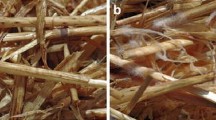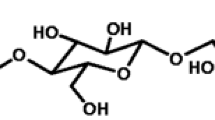Abstract
Rice straw (RS) is an important lignocellulosic biomass with nearly 800 million dry tons produced annually worldwide. RS has immense potential as a lignocellulosic feedstock for making renewable fuels and chemicals in a biorefinery. However, because of its natural recalcitrance, RS needs thermochemical treatment prior to further biological processing. Ammonia fiber expansion (AFEX) is a leading biomass pretreatment process utilizing concentrated/liquefied ammonia to pretreat lignocellulosic biomass at moderate temperatures (70–140°C). Previous research has shown improved cellulose and hemicellulose conversions upon AFEX treatment of RS at 2:1 ammonia to biomass (w/w) loading, 40% moisture (dwb) and 90°C. However, there is still scope for further improvement. Fungal pretreatment of lignocellulosics is an important biological pretreatment method that has not received much attention in the past. A few reasons for ignoring fungal-based pretreatments are substantial loss in cellulose and hemicellulose content and longer pretreatment times that reduce overall productivity. However, the sugar loss can be minimized through use of white-rot fungi (e.g. Pleutorus ostreatus) over a much shorter duration of pretreatment time. It was found that mushroom spent RS prior to AFEX allowed reduction in thermochemical treatment severity, while resulting in 15% higher glucan conversions than RS pretreated with AFEX alone. In this work, we report the effect of fungal conditioning of RS followed by AFEX pretreatment and enzymatic hydrolysis. The recovery of other byproducts from the fungal conditioning process such as fungal enzymes and mushrooms are also discussed.






Similar content being viewed by others
References
Wyman CE, Dale BE, Elander RT, Holtzapple M, Ladisch MR, Lee YY (2005) Coordinated development of leading biomass pretreatment technologies. Bioresour Technol 96:1959–1966
Dale BE (1986) Method for increasing the reactivity and digestibility of cellulose with ammonia. US Patent 4,600,590
Teymouri F, Laureano-Perez L, Alizadeh H, Dale BE (2005) Optimization of the ammonia fiber explosion (AFEX) treatment parameters for enzymatic hydrolysis of corn stover. Bioresour Technol 96:2014–2018
Gollapalli LE, Dale BE, Rivers DM (2002) Predicting digestibility of ammonia fiber explosion (AFEX) treated rice straw. Appl Biochem Biotech 98–100:23–35
Martinez AT, Speranza M, Ruiz-Duenas FJ, Ferreira P, Camarero S, Guillen G, Martinez MJ, Gutierrez A, Del-Rio JC (2005) Biodegradation of lignocellulosic:microbial, chemical and enzymatic aspects of the fungal attack of lignin. Int Microbiol 8:195–204
Chahal DS (1984) Bioconversion of hemicellulose into useful products in an integrated process for food/feed and fuel (ethanol) production from biomass. Biotechnol Bioeng Symp 14:425–433
Keller FA, Hamilton JE, Nguyen QA (2003) Microbial pretreatment of biomass:potential for reducing severity of thermo chemical biomass pretreatment. Appl Biochem Biotechnol 105–108:27–41
Taniguchi M, Suzuki H, Watanabe D, Sakai K, Hoshino K, Tanaka T (2005) Evaluation of Pretreatment with Pleurotus ostreatus for enzymatic hydrolysis of rice straw. J Biosci Bioeng 100:637–643
Cohen R, Persky L, Hadar Y (2002) Biotechnological applications and potential of wood–degrading mushrooms of the genus Pleurotus. Appl Microbiol Biotechnol 58:582–594
Israilides C, Philippoussis A (2003) Bio-technologies of recycling agro-industrial wastes for the production of commercially important fungal polysaccharides and mushrooms. Biotechnol Genet Eng Rev 20:247–259
Poppe J (2000) Use of agricultural waste materials in the cultivation of mushrooms. In: Griensven V (ed) Science and cultivation of edible fungi. Balkema, Rotterdam, pp 3–23
World mushroom industry production report prepared by USDA Economics and Statistics System. http://usda.mannlib.cornell.edu/MannUsda/viewDocumentInfo.do?documentID=1395
Chang S-T (2006) The world mushroom industry: trends and technological development. Int J Med Mushrooms 4:108
Stamets P (2005) Mycelium running: how mushrooms can help save the world. Ten Speed Press, California
Zhang R, Li X, Fadel JG (2002) Oyster mushroom cultivation with rice and wheat straw. Bioresour Technol 82:277–284
Obodai M, Cleland-Okine J, Vowotor KA (2003) Comparative study on the growth and yield of pleurotus ostreatus mushroom on different lignocellulosic by-products. J Ind Microbiol Biotechnol 30:146–149
Williams BC, McMullan JT, McCahey S (2001) An initial assessment of spent mushroom compost as a potential energy feedstock. Bioresour Technol 79:227–230
Singh A, Sharma S (2002) Composting of a crop residue through treatment with microorganisms and subsequent vermi-composting. Bioresour Technol 85:107–111
Karunanandaa K, Varga GA, Akin DE, Rigsby LL, Royse DJ (1995) Botanical fractions of rice straw colonized by white-rot fungi:changes in chemical composition and structure. Anim Feed Sci Technol 55:179–199
Sanchez A, Ysunza F, Beltran-Garcia MJ, Esqueda M (2002) Biodegradation of viticulture wastes by Pleurotus: a source of microbial and human food and its potential use in animal feeding. J Agric Food Chem 50:2537–2342
Houghton TP, Thompson DN, Hess JR, Lacey JA, Wolcott MP, Schirp A, Englund K, Dostal D, Loge F (2004) Fungal upgrading of wheat straw for straw-thermoplastic production. Appl Biochem Biotechnol 113–116:71–93
O’Connor JJ (1972) Ammonia explosion pulping. Tappi 55:353
Turner ND, McDonough CM, Byers FM, Holtzapple MT, Dale BE, Jun JH, Greene LW (1990) Disruption of forage structure with an ammonia fiber explosion process. Proceedings, Western Section, American Society of Animal Sciences. J Anim Sci 68:194
Sulbaran de Ferrer B, Aristiguieta M, Dale BE, Ferrer A, Ojeda-de-Rodriguez (2003) Enzymatic hydrolysis of ammonia-treated rice straw. Appl Biochem Biotechnol 105–108:155–164
Eggeman T, Elander RT (2005) Process and economic analysis of pretreatment technologies. Bioresour Technol 96:2019–2025
Chandawat SPS, Balan V, Dale BE (2007) Effect of particle size based separation of milled corn stover on AFEX pretreatment and enzymatic digestibility. Biotechnol Bioeng 96:219–231
Protein estimation and sugar analysis protocol. http://www.dairyone.com/Forage/Procedures/default.htm
LAP protocol available at National Renewable Energy Lab website: http://www.nrel.gov/biomass/analytical_procedures.html
Goodman EF (1996) Moisture absorbing materials and methods of production. US Patent 5,503,931
Ribeiro B, Rangel J, Valentao P, Baptista P, Seabra RM, Andrade PB (2006) Contents of carboxylic acids and two phenolics and antioxidant activity of dried Portuguese wild edible mushrooms. J Agric Food Chem 54:8530–8537
Baldrian P, Gabriel J (2002) Variability of Laccase activity in the white-rot Basidomycete Pleurotus ostreatus. Folia Microbiol 47:385–390
Christian V, Shrivastava R, Shukla D, Modi HA, Vyas BRM (2005) Degradation of xenobiotic compounds by lignin-degrading white-rot fungi: enzymology and mechanism involved. Ind J Exp Biol 43:301–312
Acknowledgments
We would like to thank Dr. Taniguchi for giving permission to reproduce one of his figures in our manuscript. Funding for this project was provided through the MSU Research Foundation. Also, we would like to thank Fungi Perfecti Co. for generously providing us with the mushroom patches and UT-RS. We would like to thank Mr. Rajesh from Auburn University for doing composition analysis for our samples.
Author information
Authors and Affiliations
Corresponding author
Additional information
JIMB-2008: BioEnergy—Special issue.
Rights and permissions
About this article
Cite this article
Balan, V., da Costa Sousa, L., Chundawat, S.P.S. et al. Mushroom spent straw: a potential substrate for an ethanol-based biorefinery. J Ind Microbiol Biotechnol 35, 293–301 (2008). https://doi.org/10.1007/s10295-007-0294-5
Received:
Accepted:
Published:
Issue Date:
DOI: https://doi.org/10.1007/s10295-007-0294-5




